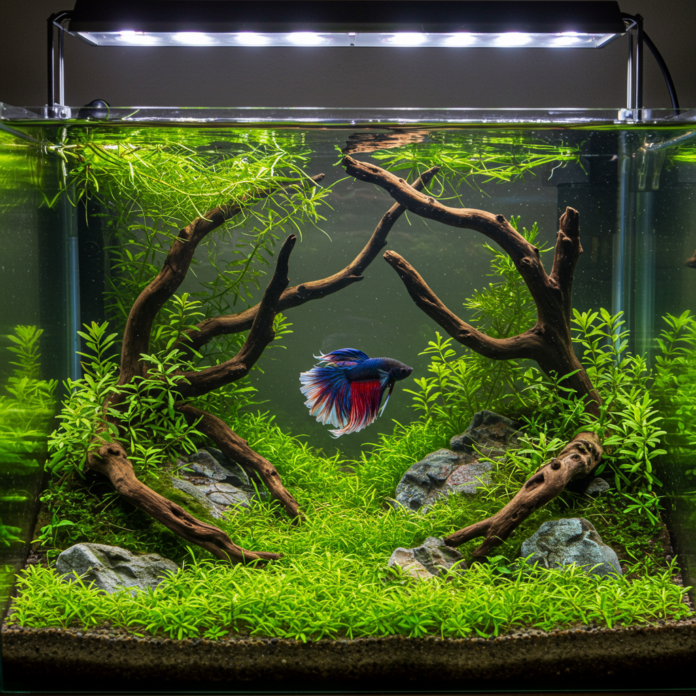Your Comprehensive Guide to Setting Up the Ideal Betta Fish Habitat
Betta fish, also known as Siamese fighting fish, are beloved for their vibrant colors and flowing fins. Providing them with the perfect home is essential to ensure they thrive and display their full splendor. This guide will walk you through every aspect of setting up an optimal Betta tank, from choosing the right tank size to fine-tuning water parameters, selecting filtration systems, and adding decorative touches that make your Betta feel right at home.
Table of Contents
- Choosing the Right Tank Size
- Understanding Water Parameters
- Selecting Filtration Systems
- Heating and Lighting Essentials
- Decoration Tips for a Betta-Friendly Environment
- Setting Up the Tank: Step-by-Step
- Cycling the Tank Before Introducing Your Betta
- Conclusion
- FAQs
Choosing the Right Tank Size
Why Tank Size Matters
Contrary to popular belief, Betta fish do not thrive in tiny bowls or cups. In their natural habitat, Bettas inhabit rice paddies and slow-moving streams, giving them ample space to explore.
- Minimum Recommended Size: 5 gallons (19 liters)
- Smaller tanks can lead to rapid toxin build-up and temperature fluctuations.
- Benefits of a Larger Tank:
- Stable Water Conditions: Larger volumes dilute toxins and stabilize temperature.
- Enhanced Well-being: More space reduces stress and promotes natural behaviors.
- Creative Freedom: Allows for more decorations and enrichment items.
Tank Shape Considerations
- Rectangular Tanks: Provide more horizontal swimming space.
- Avoid Tall Tanks: Bettas breathe air from the surface; taller tanks make this harder.
Tip: Invest in the largest tank your space and budget allow. Your Betta will thank you!
Understanding Water Parameters
Essential Water Conditions for Betta Health
Maintaining optimal water parameters is crucial for your Betta’s longevity and vibrancy.
- Temperature: 76–82°F (24–28°C)
- Heater Needed: Bettas are tropical fish and require consistent warmth.
- pH Level: 6.5–7.5
- Slightly acidic to neutral water is ideal.
- Water Hardness:
- Soft to Moderately Hard: Aim for 3–6 dGH (degrees of general hardness).
- Ammonia, Nitrite, Nitrate:
- Ammonia and Nitrite: 0 ppm (parts per million)
- Nitrate: Below 20 ppm
Regular Testing
Use a reliable water testing kit to monitor parameters weekly.
- Test Strips: Convenient but less accurate.
- Liquid Test Kits: More precise and cost-effective over time.
Visualization: Ideal Water Parameter Ranges
| Parameter | Ideal Range |
|---|---|
| Temperature | 76–82°F (24–28°C) |
| pH Level | 6.5–7.5 |
| Hardness | 3–6 dGH |
| Ammonia | 0 ppm |
| Nitrite | 0 ppm |
| Nitrate | < 20 ppm |
Selecting Filtration Systems
Why Filtration is Important
A good filtration system keeps the water clean, reduces toxins, and promotes a healthy environment.
Features to Look For
- Adjustable Flow Rate:
- Bettas prefer calm waters; strong currents can stress them.
- Three-Stage Filtration:
- Mechanical: Removes debris.
- Biological: Houses beneficial bacteria.
- Chemical: Eliminates odors and discoloration (often using activated carbon).
Types of Filters
- Sponge Filters:
- Pros: Gentle flow, excellent biological filtration.
- Cons: May require an air pump.
- Internal Filters:
- Pros: Compact, adjustable flow.
- Cons: Takes up space inside the tank.
- Hang-On-Back (HOB) Filters:
- Pros: Efficient, easy maintenance.
- Cons: Flow may need to be reduced.
Tip: Use a baffle or sponge to reduce filter output if the current is too strong.
Heating and Lighting Essentials
Heating
- Consistent Temperature: Use a reliable heater with a built-in thermostat.
- Heater Placement: Position near water flow areas for even heat distribution.
- Thermometer: Install an aquarium thermometer to monitor temperature daily.
Lighting
- Lighting Needs: Bettas don’t require special lighting but benefit from a regular day-night cycle.
- Light Duration: 8–12 hours of light per day.
- Avoid Direct Sunlight: Can cause algae growth and temperature spikes.
Recommendation: Use a timer to automate your tank’s lighting schedule.
Decoration Tips for a Betta-Friendly Environment
Creating a Natural Habitat
Decorations provide enrichment, reduce stress, and enhance the tank’s aesthetics.
Live Plants
- Benefits:
- Improve water quality by absorbing nitrates.
- Offer hiding spots and resting places.
- Easy-to-Grow Options:
- Anubias Nana
- Java Fern
- Amazon Sword
- Marimo Moss Balls
Artificial Plants
- Silk Plants: Preferred over plastic to prevent fin damage.
- Placement: Arrange to create exploration pathways.
Substrate
- Gravel:
- Pros: Easy to clean, available in various colors.
- Cons: Debris can get trapped.
- Sand:
- Pros: Natural look, suitable for live plants.
- Cons: Can compact over time.
Ornaments and Hiding Spots
- Caves and Logs:
- Provide shelter and reduce anxiety.
- Floating Decorations:
- Bettas enjoy resting near the surface.
- Safety Check:
- Ensure all decorations are aquarium-safe with no sharp edges.
DIY Idea: Use smooth ceramic mugs or PVC pipes as inexpensive caves.
Setting Up the Tank: Step-by-Step
1. Rinse the Tank and Equipment
- Use warm water; avoid soap or chemicals.
2. Add Substrate
- Rinse substrate thoroughly before adding.
- Layer evenly on the tank bottom (2–3 inches).
3. Install Equipment
- Heater: Place near the filter for circulation.
- Filter: Set up according to the manufacturer’s instructions.
4. Add Water
- Fill the tank with treated tap water.
- Dechlorinator: Essential to remove harmful chlorine and chloramines.
5. Arrange Decorations and Plants
- Place taller plants at the back.
- Create hiding spots with caves and ornaments.
6. Start the Equipment
- Plug in the filter and heater.
- Verify that everything functions properly.
7. Cycle the Tank
- Nitrogen Cycle: Builds beneficial bacteria that break down waste.
- Duration: Typically 4–6 weeks.
Cycling the Tank Before Introducing Your Betta
Importance of Cycling
Cycling establishes a colony of beneficial bacteria essential for processing fish waste.
Steps to Cycle the Tank
Add an Ammonia Source:
- Pure ammonia or fish food can be used.
Test Water Regularly:
- Monitor ammonia, nitrite, and nitrate levels.
Wait for Parameters to Stabilize:
- Ammonia and nitrite levels should drop to 0 ppm.
- Nitrate levels will rise, indicating the cycle is complete.
Using Beneficial Bacteria Supplements
- Products like Seachem Stability can speed up the cycling process.
Patience is Key: Introducing your Betta before cycling completes can expose it to harmful toxins.
Conclusion
Setting up the perfect Betta tank involves thoughtful planning and attention to detail. By providing the right tank size, maintaining optimal water parameters, selecting appropriate filtration, and creating an engaging environment with decorations and plants, you’re setting the stage for your Betta to live a healthy and stimulating life.
Remember, the needs of your Betta extend beyond basic survival—they thrive when their environment closely mimics their natural habitat. Investing time and resources into creating this space not only benefits your fish but also enhances your enjoyment as you observe their natural behaviors and vibrant personality.
Explore More: Interested in learning about Betta fish behaviors or feeding routines? Check out our other articles to become a Betta expert!
FAQs
Q: Can I keep a Betta fish in a bowl without a filter?
A: It’s not recommended. Bettas need at least a 5-gallon tank with a filter to maintain water quality and provide a stable environment.
Q: Do Betta fish need a heater even in warm climates?
A: Unless your room temperature consistently stays within the ideal range (76–82°F), a heater is essential to prevent temperature fluctuations.
Q: How often should I clean my Betta’s tank?
A: Perform partial water changes of 25% weekly and monitor water parameters to determine if more frequent changes are needed.
Ready to create the perfect home for your Betta? Share your tank setup experiences or ask questions in the comments below!
Disclaimer: This article is for informational purposes only. Always consult a professional aquarist or veterinarian for specific advice regarding your Betta fish.


